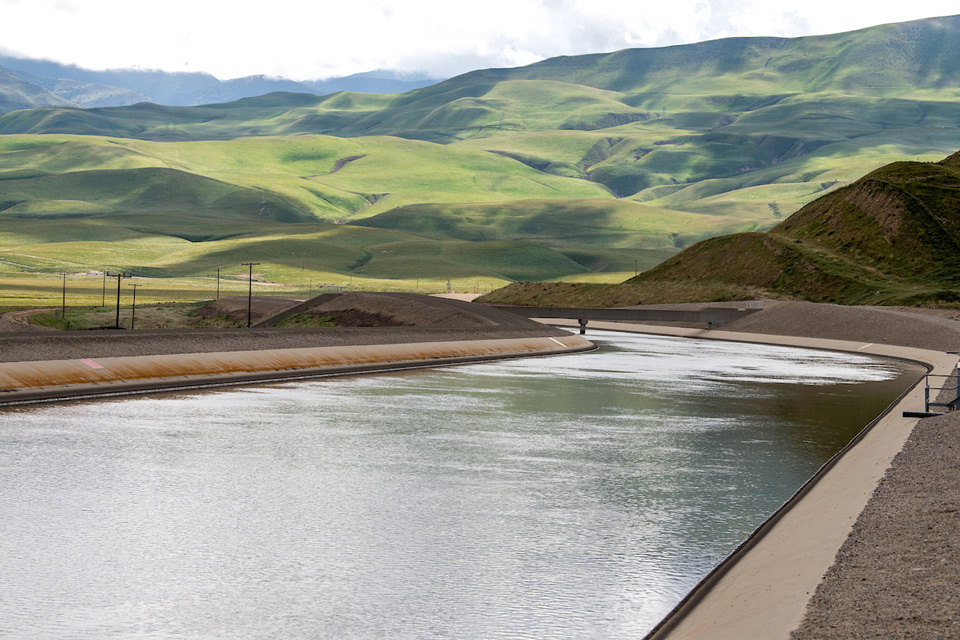A section of the California Aqueduct within the California State Water Project, located near Wheeler Ridge, which convey California Aqueduct water between Ira J. Chrisman Wind Gap and Edmonston Pumping Plants within Kern County. In the background is the Tehachapi Mountains. DWR/2019
March 24, 2021 - SACRAMENTO, Calif. – As California experiences a second consecutive dry year, on Tuesday the California Department of Water Resources (DWR) announced an adjustment to its initial State Water Project (SWP) allocation for the 2021 water year. The department now expects to deliver 5 percent of requested supplies this year, down from the initial allocation of 10 percent announced in December.
Initial allocations are based on conservative assumptions regarding hydrology and factors such as reservoir storage. Allocations are reviewed monthly and may change based on snowpack and runoff information. They are typically finalized by May.
“We are now facing the reality that it will be a second dry year for California and that is having a significant impact on our water supply,” said DWR Director Karla Nemeth. “The Department of Water Resources is working with our federal and state partners to plan for the impacts of limited water supplies this summer for agriculture as well as urban and rural water users. We encourage everyone to look for ways to use water efficiently in their everyday lives.”
Ongoing drought conditions require the coordination of federal, state and local agencies. Today, the U.S. Bureau of Reclamation, which operates the Central Valley Project, is also expected to adjust its initial CVP water supply allocation accordingly. Yesterday, the State Water Resources Control Board mailed early warning notices to approximately 40,000 water right holders urging them to plan for potential shortages by reducing water use and adopting practical conservation measures.
As a result of the persistent drought conditions, and in accordance with its permit for the long-term operation of the State Water Project, DWR has submitted a revised Drought Contingency Plan to the California Department of Fish and Wildlife. The plan provides updated hydrologic conditions and outlines areas of concern for the joint operations of the State Water Project and the Central Valley Project, water quality, and environmental impacts.
DWR does not anticipate the need to pursue a Temporary Urgency Change Petition (TUCP) to allow for temporary changes to the water quality and outflow requirements for the Sacramento-San Joaquin Delta.
The severity of the situation is particularly evident in the North State. Lake Oroville is currently at 53 percent of average. The Feather River watershed, which feeds into Lake Oroville, has seen significantly less precipitation this year than normal, on track for its second driest year on record. Following a below average 2020 water year, California’s major reservoirs are at 50 percent of capacity.
California is better prepared for drought than in the past. Following the 2012-2016 drought, DWR enacted many programs focused on managing the state’s water through a strategic, integrated approach with a strong emphasis on water use efficiency and conservation. The state provides assistance and tools to local water agencies to help them reduce their drought vulnerability. DWR’s Water Use and Efficiency Branch (WUE) provides agencies and individuals assistance for improving water use efficiency and developing and meeting efficient water use requirements.
The 5 percent allocation amounts to 210,266 acre-feet of water, distributed among the 29 long-term SWP contractors who serve more than 27 million Californians and 750,000 acres of farmland.
Allocations represent the amount of SWP water that DWR will deliver for the year and are reviewed monthly based on several factors, such as water in storage, environmental requirements, and rain and snow runoff projections. For 2020, the initial SWP allocation was 10 percent and the final allocation was 20 percent in May.
For information on current water conditions at the state’s largest reservoirs and weather stations, visit the California Data Exchange Center website.
Source: CA. DWR









